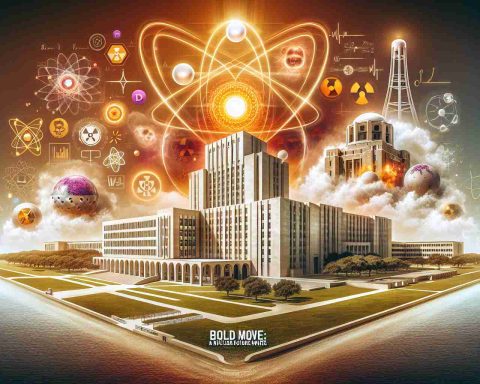- The Natrium project combines a 345 MW sodium-cooled fast reactor with advanced molten-salt storage, aiming to reshape nuclear perceptions.
- It integrates nuclear and renewable energy to enhance grid stability and reduce fossil fuel reliance.
- This initiative could improve electricity access and economic conditions, especially in underserved regions.
- Public trust and transparent communication are pivotal to overcoming fears from past nuclear incidents.
- Economic benefits include innovation and job creation, but challenges lie in financial and regulatory navigation.
- The project’s success depends on balancing advanced technologies with environmental sustainability in pursuit of a carbon-neutral future.
Nuclear Innovation on the Horizon
In a landmark move, the Wyoming Industrial Siting Council has ignited TerraPower’s audacious Natrium project, which combines cutting-edge technology with ambitious environmental goals. At its core is the simultaneous use of a 345 megawatt sodium-cooled fast reactor and an advanced molten-salt storage system—a combination poised to change how the world perceives nuclear energy.
Fusing the Old with the New
The project boldly integrates nuclear technology with renewable energy, signaling a fresh chapter in sustainable power generation. This strategic blend offers energy resilience and efficient grid stability, paving a path for reduced reliance on fossil fuels. However, TerraPower must skillfully navigate the tricky waters of nuclear waste management and maintain stringent safety protocols to avert environmental mishaps.
Bridging the Energy Divide
With global energy demands rising, Natrium promises to enhance electricity access, potentially transforming underserved regions worldwide. By stabilizing the energy grid, the project could improve living standards and spur economic development. Yet, gaining public trust remains a hurdle, requiring transparent communication and educational efforts to dispel fears rooted in past nuclear incidents.
Economic Gains vs. Challenges
Economically, Natrium is set to stimulate innovation and job creation, especially in Wyoming, oscillating between promise and complexity. Partnering with ASP Isotopes, TerraPower aims to boost U.S. energy self-reliance and cut foreign dependencies. However, navigating financial investments and regulatory landscapes will be crucial for realizing potent economic benefits.
The Crossroad of Energy Innovation
As TerraPower advances, the Natrium project finds itself at the intersection of groundbreaking opportunity and challenge. Success hinges on the project’s ability to harmonize cutting-edge technologies with sustainable practices, offering a viable compass for a carbon-neutral future. In the unfolding tale of nuclear innovation, Natrium could either forge a new energy trajectory for generations or face the daunting task of uncharted territories.
The Future of Nuclear: Game-Changing Innovations and Their Impact
Natrium’s Technological Edge
The Natrium project spearheaded by TerraPower is not just a groundbreaking development but a pivotal shift in nuclear technology. By incorporating a 345 megawatt sodium-cooled fast reactor alongside an advanced molten-salt storage system, Natrium redefines the potential of nuclear energy. This innovation addresses challenges in grid stability and energy resilience, marking a stride towards diminishing fossil fuel dependency.
Balancing Nuclear Advancement with Environmental Concerns
Integrating nuclear technology with renewable solutions is a noteworthy stride towards a sustainable energy future. However, TerraPower must prioritize robust nuclear waste management strategies and uphold safety protocols to prevent environmental repercussions. Public perception hinges on how well these issues are managed, underscoring the need for transparency and effective communication.
Economic Implications and Strategic Partnerships
While Natrium promises economic rejuvenation in regions like Wyoming through job creation and innovation, it must deftly maneuver through financial investments and regulatory frameworks. TerraPower’s collaboration with ASP Isotopes is a strategic endeavor to achieve energy self-sufficiency for the U.S., reducing foreign energy dependencies and fostering national security.
Is Natrium a Game Changer for Global Energy Access?
What makes the Natrium project’s technology uniquely impactful?
Natrium’s distinctiveness lies in its integration of a sodium-cooled fast reactor with molten-salt energy storage. This combination enhances energy efficiency and stability by ensuring that energy production aligns with grid demands, reducing waste and optimizing resource use. Such technology is pivotal for transitioning to a carbon-neutral energy landscape.
How might the Natrium project influence the global economy?
Globally, Natrium could significantly impact energy affordability and accessibility, particularly in regions with limited electricity infrastructure. By improving grid stability and lowering energy costs, it can drive economic development, improve living standards, and stimulate job creation across different sectors, thereby influencing global economic landscapes.
What are the main challenges to public acceptance of the Natrium project?
Ensuring transparency and education is crucial for public acceptance. Previous nuclear incidents have instilled fear and skepticism, requiring TerraPower to proactively communicate safety measures, manage nuclear waste responsibly, and showcase the project’s environmental and economic benefits to gain trust and support from communities.
For more about innovative energy solutions, you can visit the TerraPower website.
The source of the article is from the blog mendozaextremo.com.ar












